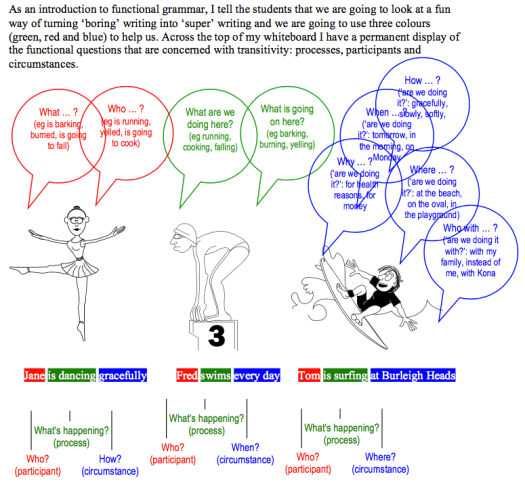Reflections on Step-by-Step With Functional Grammar by Fiona Kettle-Muspratt, in the same style as the previous Cheat Sheet (#1), but this time focussed on processes, participants, circumstances, describers and qualifiers
The field of expressing language has ideational meaning. To figure out what is going on, functional grammar usually divides parts field participants, processes and circumstances into colours (See beneath). In order to figure out which is which, the same three probe questions can be asked:
- To find the participant(s):
- “Who or what?”
- To find the process(es):
- “What is happening?”
- To find the circumstance(s):
- “Where, when, how, why?”

(Figure, p. 11)
The Participants
- Noun group
- The people or entities involved
- The participants can be:
- Sensing (feeling) or experiencing something
- The one acting in the sentence
- Can be the receiver of an action (impacted or affected by)
- Saying something
- Participants are linked by processes realised by verbs
The Processes
- Verbal group
- Halliday identified 6 process types (2004) :
- Material – processes of doing (work, arrest, erupt, climb, elect…)
- Relational – processes of being and having (be, have, stand …)
- Mental – processes of sensing and feeling (feel, think, wish, believe …)
- Verbal – processes of saying (say, tell, report, write, command, deny…)
- Behavioural – processes of human behaviour (sleep, cough, look, listen…)
- Existential – processes which are signalled by there, such as there is/there are
The Circumstances
- Adverbial group
- Any further details in the clause? Circumstances answers:
- When
- Why
- Where
- How
Kettle-Muspratt present this worksheet/grid concept, that can be extended to expose the students to the range of functional groups in the nominal group.
Here are some examples:


(pp.7-8)
Literature:
Halliday, M.A.K. & Matthiessen, C.M.I.M.. (2004): Introduction to Functional Grammar (3rd Edition). London: Arnold.
Kettle-Muspratt, F. (2009): Step-by-step With Functional Grammar.
